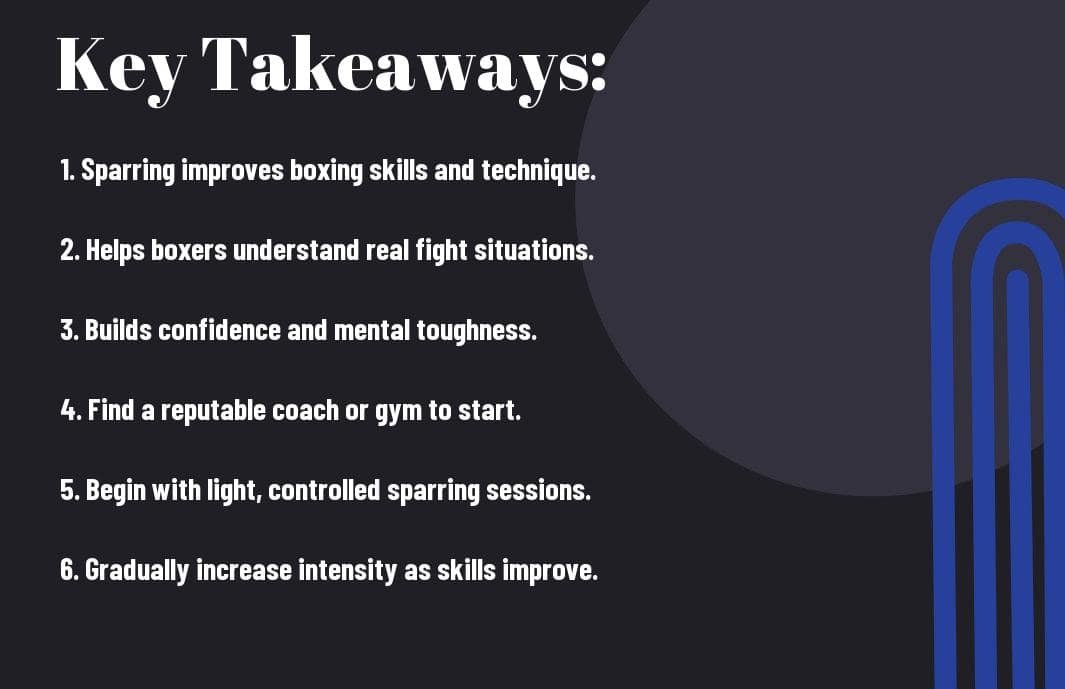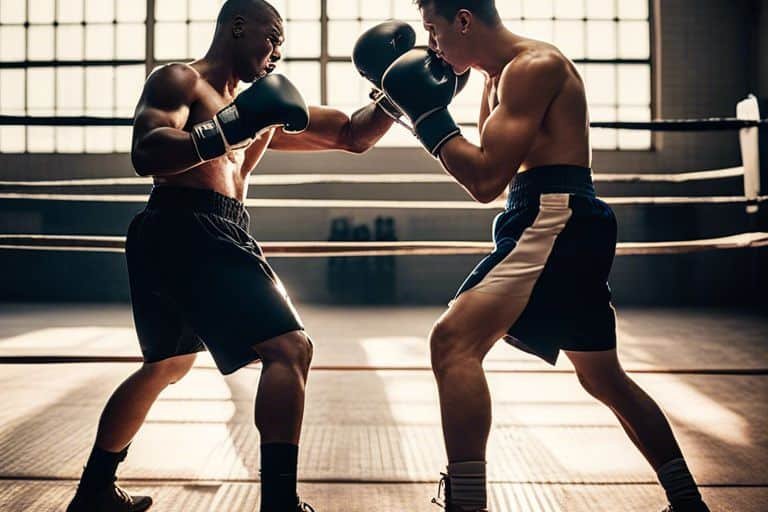Embarking on your boxing journey can be intimidating, but sparring is an essential aspect of your training that should not be overlooked. Not only does it allow you to apply your skills in a real-life scenario, but it also improves your speed, timing, and overall technique. However, before jumping into the ring, it’s crucial to learn the basics and find a reputable coach. Once you’re ready, sparring can bring a new level of challenge and excitement to your boxing practice.
Key Takeaways:
- Improves Skills: Sparring helps boxers improve their overall boxing skills by practising and refining techniques in a realistic environment.
- Physical Conditioning: It boosts physical fitness, endurance, and agility, preparing boxers for actual competition.
- Mental Toughness: Sparring teaches boxers to think on their feet, stay calm under pressure, and develop strategic thinking.
- Learn from Others: It provides an opportunity to spar with different opponents, learning from their styles and strategies.
- Follow Proper Protocol: To start sparring, beginners should find a qualified trainer, invest in proper equipment, and begin with light, controlled sessions.

The Importance of Sparring in Boxing
When it comes to boxing, sparring is an essential part of your training regime. Not only does it help you put your skills to the test, but it also has numerous other benefits that contribute to your overall development as a boxer. Understanding the importance of sparring and how it can benefit you is crucial in your journey to becoming a skilled and successful boxer.
Technique Refinement and Muscle Memory
During sparring sessions, you have the opportunity to put the techniques you’ve learned into practice in a realistic setting. This helps to refine your technique and develop muscle memory, allowing you to perform movements and combinations instinctively, without having to consciously think about each movement. This is crucial in a high-pressure environment such as a boxing match, where split-second decisions can make all the difference.
Ring Awareness and Strategic Thinking
Sparring also helps you to develop ring awareness and strategic thinking in the context of a bout. You will learn how to position yourself in the ring, how to move around your opponent, and how to anticipate and defend against their attacks. This not only improves your overall boxing ability but also hones your ability to think strategically and make quick, effective decisions during a match.
Stamina and Conditioning
Engaging in regular sparring sessions is an excellent way to improve your stamina and conditioning. Boxing matches can be physically demanding, and sparring provides an opportunity to simulate the intensity of a real fight, allowing you to build up your endurance and cardiovascular fitness. The more you spar, the better your body will adapt to the rigours of a match, ultimately enhancing your overall performance in the ring.
Safety First: Preparing to Spar
Before you start sparring, it’s crucial to make sure you are properly prepared in terms of safety. This means having the right gear, protective equipment, and a qualified trainer or safe partner to guide you through the process.
Essential Gear and Protective Equipment
When preparing to spar, you need to ensure you have the essential gear and protective equipment to keep yourself safe. This includes wearing a well-fitted mouthguard to protect your teeth and gums from impact, as well as hand wraps and boxing gloves to support and cushion your hands during sparring. Additionally, it’s important to invest in a good quality headguard to minimise the risk of head injuries. Wearing appropriate clothing and footwear that allows for ease of movement and protection is also essential to minimise the risk of injury.
The Role of a Qualified Trainer and Safe Partner
Having a qualified trainer or a safe sparring partner is vital for your safety during sparring sessions. A qualified trainer will provide you with the necessary guidance, correct your techniques, and ensure that you are progressing at a safe and manageable pace. They will also be able to create a controlled sparring environment, where you can practice your skills with minimal risk of injury. Your sparring partner should also be trained and aware of your skill level, helping to create a challenging yet safe sparring experience for you.
Remember, sparring is an important part of boxing training, but safety should always come first. By ensuring you have the right gear, protective equipment, and a qualified trainer or safe partner, you can enjoy the benefits of sparring while minimising the risk of injury.
Sparring Drills and Progressive Training
When it comes to sparring in boxing, it’s not just about getting in the ring and throwing punches. It’s a methodical process that involves specific drills and progressive training to help you develop your skills and technique.
Basic Sparring Drills for Beginners
If you’re just starting out on your boxing journey, it’s essential to focus on mastering the fundamental sparring drills. These drills will help you to get comfortable in the ring and develop the basic skills you need to become a successful boxer. Some basic sparring drills for beginners include:
Advanced Tactics for Experienced Boxers
Once you’ve mastered the basic sparring drills, you can start incorporating more advanced tactics into your training. These tactics will help you to refine your technique and take your sparring to the next level. Some advanced tactics for experienced boxers include:
- Footwork: Improving your footwork can give you a significant advantage in the ring, allowing you to move quickly and effectively.
- Defensive Techniques: Learning advanced defensive techniques such as slipping, rolling, and blocking can help you to avoid taking unnecessary hits.
- Counter Punching: Mastering the art of counter punching can make you a formidable opponent, allowing you to turn your opponent’s attacks into opportunities for your own.
- Strategic Sparring: Engaging in strategic sparring with a focus on specific skills or tactics can help you to target areas for improvement and track your progress.
- Conditioning and Endurance: Advanced boxers should also focus on conditioning and endurance training to ensure they can maintain their skills throughout longer sparring sessions and fights.
Step-by-Step Guide to Starting Sparring
When it comes to starting sparring in boxing, it’s important to approach it methodically and with the right guidance. Here’s a step-by-step guide to help you get started:
| Step 1: Finding the Right Boxing Gym and Sparring Community | Step 2: Integrating Sparring into Your Existing Training Routine |
| Look for a reputable boxing gym with experienced coaches who can provide proper guidance and ensure your safety during sparring sessions. A supportive and inclusive sparring community is crucial for your development as a boxer. | Gradually introduce sparring into your training routine, focusing on technique, footwork, and defensive strategies. It’s important to communicate with your coach and sparring partners about your comfort level and gradually increase the intensity as you progress. |
Finding the Right Boxing Gym and Sparring Community
When starting sparring, finding the right boxing gym and sparring community is crucial for your development as a boxer. Look for a gym with experienced coaches who prioritise safety and proper technique. A supportive and inclusive sparring community will provide you with the necessary guidance and challenges to enhance your skills.
Integrating Sparring into Your Existing Training Routine
Integrating sparring into your existing training routine should be a gradual process focused on technique, footwork, and defensive strategies. Communicate with your coach and sparring partners about your comfort level and gradually increase the intensity as you progress. Consistent and structured sparring sessions will help you develop confidence and adapt to real boxing scenarios.
Conclusion
Following this guide, you now understand the importance of sparring in boxing and how it can benefit your overall skill and performance. Engaging in sparring sessions allows you to put your training into practice, learn from your mistakes, and improve your technique and timing. To start sparring, find a reputable boxing gym or club with experienced trainers who can guide you through the process and ensure your safety. Remember to always use proper protective gear and communicate with your sparring partner to ensure a safe and productive session. For more insights on the importance of sparring and tips on how to improve, check out this article on Importance of Sparring and How to Improve.
FAQ
Q: Why is sparring important in boxing?
A: Sparring is important in boxing as it allows boxers to apply their skills in a real-life scenario, improving their technique, timing, and defensive abilities.
Q: How does sparring benefit a boxer?
A: Sparring helps boxers to develop their fighting instincts, improve physical conditioning, and gain valuable experience in the ring.
Q: What should I expect during a sparring session?
A: During a sparring session, you can expect to face an opponent of similar skill level, with a focus on controlled and technical boxing rather than full-force fighting.
Q: Is sparring dangerous for beginners?
A: Sparring can be dangerous for beginners if not conducted in a controlled environment with proper supervision and safety gear. It is important to start sparring at a pace that matches your skill level and experience.
Q: How can I start sparring in boxing?
A: To start sparring in boxing, it is recommended to first master the fundamental techniques and footwork. You should then seek guidance from a qualified coach who can gradually introduce you to sparring in a safe and controlled manner.
Q: What gear is required for sparring in boxing?
A: Essential gear for sparring in boxing includes headgear, mouthguard, hand wraps, boxing gloves, and groin protector for males. It is crucial to invest in high-quality gear to ensure maximum protection during sparring sessions.
Q: How often should I engage in sparring sessions?
A: The frequency of sparring sessions should be determined by your coach based on your skill level and physical conditioning. Typically, beginners may start with one to two sessions per week, gradually increasing as they progress in their training.



